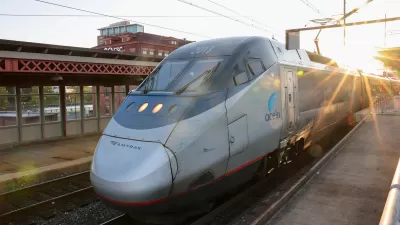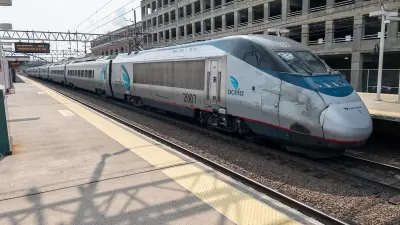With a flurry of ambitious, and big ticket, proposals unveiled over the past three weeks, chronically under-budgeted Amtrak is shifting its strategy in the hopes of proving its potential worth.
With recent proposals to renovate Washington's Union Station at a cost of $7 billion and bring high-speed rail to the Northeast Corridor for a measly $151 billion, Amtrak doesn't seem so dowdy any longer.
In an audacious strategy, Amtrak, "which got a $1.4 billion federal subsidy this year and needs congressional reauthorization to continue operations past September 2013," has liberated itself from the minor inconveniences of begging for funds to keep rolling every year, in the hopes of proving its potential long-term value.
"It's an aggressive strategy to put themselves in a better negotiating position," said Joshua Schank, president and chief executive officer of the Eno Center for Transportation, a Washington research group. "Rather than playing defense and asking for a little bit of money so they just don't die, they're saying, ‘Here's what we could accomplish if we really get some money.'"
Detractors argue for a free market solution to American passenger rail. "A better solution would open up Amtrak routes to competitive bidding to lower costs," says the author summarizing Emily Goff of the Heritage Foundation.
The $151 billion high-speed rail plan includes both, with government funding expected to attract private investment. Amtrak hopes ambitious plans can attract sovereign wealth funds that are increasingly looking for ways to invest in U.S. transportation projects, notes Plungis.
Thanks to Andrew Gorden
FULL STORY: Amtrak Shifts Strategy From Begging for Money to Thinking Big

Maui's Vacation Rental Debate Turns Ugly
Verbal attacks, misinformation campaigns and fistfights plague a high-stakes debate to convert thousands of vacation rentals into long-term housing.

Planetizen Federal Action Tracker
A weekly monitor of how Trump’s orders and actions are impacting planners and planning in America.

In Urban Planning, AI Prompting Could be the New Design Thinking
Creativity has long been key to great urban design. What if we see AI as our new creative partner?

Massachusetts Budget Helps Close MBTA Budget Gap
The budget signed by Gov. Maura Healey includes $470 million in MBTA funding for the next fiscal year.

Milwaukee Launches Vision Zero Plan
Seven years after the city signed its Complete Streets Policy, the city is doubling down on its efforts to eliminate traffic deaths.

Portland Raises Parking Fees to Pay for Street Maintenance
The city is struggling to bridge a massive budget gap at the Bureau of Transportation, which largely depleted its reserves during the Civd-19 pandemic.
Urban Design for Planners 1: Software Tools
This six-course series explores essential urban design concepts using open source software and equips planners with the tools they need to participate fully in the urban design process.
Planning for Universal Design
Learn the tools for implementing Universal Design in planning regulations.
Gallatin County Department of Planning & Community Development
Heyer Gruel & Associates PA
JM Goldson LLC
City of Camden Redevelopment Agency
City of Astoria
Transportation Research & Education Center (TREC) at Portland State University
Jefferson Parish Government
Camden Redevelopment Agency
City of Claremont





























